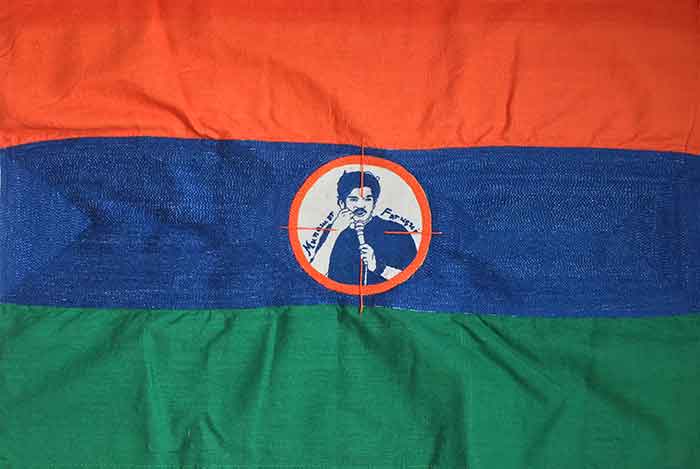The intruder [Gaur] was referring not to a joke Faruqui had just made, but one that he’d uploaded on YouTube in April 2020. It referenced Rama, a widely worshipped Hindu deity, and his wife Sita. “O Lord, my beloved, has come home,” Faruqui starts, dropping lyrics from an enormously popular Bollywood song in which a woman celebrates the return of her lover. Then comes the punchline: “Ramji don’t give a f-ck about your beloved.” The audience erupts. “He says, ‘I myself haven’t returned home for fourteen years.” — How An Indian Stand Up Comic Found Himself Arrested for a Joke He Didn’t Tell, TIME, February 10.
It seems for India’s ruling BJP government and its tentacles, like Eklavya Singh Gaur–the son of BJP legislator Malini Gaur–Rama and Sita, holy cows, and all things Hindu, are just a convenient catalyst to carry out atrocities against Faruqui and other Indian Muslims, smothering their voices and making their lives a living hell.
On New Year’s Day this year, 29-year-old Faruqui was set to perform in a café in Indore, Madhya Pradesh, when he was approached by Gaur, who accused him of hurting the fragile sentiments of Hindus like him. By the end of the evening, after a lot of back and forth among Faruqui, his audience supporters and Gaur, he was arrested by the police along with the show’s producer Edwin Anthony, its host Nalin Yadav, its opening performer Prakhar Vyas and his 17-year-old brother. A few days later, the police also arrested a friend of Faruqui, Sadaqat Khan.
Since Vyas’s brother was a minor, he got bail before anyone else. Faruqui was released on bail on February 6, and a few days after that Anthony and Vyas were also granted bail. Yadav and Khan are still in jail.

Part of a continuing series, these JatiIndia Flags feature a face of resistance to upper-caste violence and injustice at the center of a modified flag of India. The color orange symbolizes Hindutva politics; blue—a color historically adopted by the Dalit movement—here represents the country’s Dalits, Kashmiris, Adivasis and other minorities; the bottom green bar embodies the regions ecological foundations endangered by the ideology of extractive capitalism; the circular image, replacing the Dharma Chakra (Wheel of Law) signifies the view through the crosshairs of a saffron (Hindu nationalist) gunsight.
The blue strip is done in chain-stitch embroidery, illustrating the long chain of atrocities that have been carried out by JatiIndia over the years on its own people, and the people of occupied Kashmir. Each blue chain-stitch, of which there are more than twenty thousand, represents a face of resistance.
My name is Munawar Iqbal Faruqui. I was born and brought up in Gujarat. I survived Gujarat. I had delivered this joke, and folks got upset… so I wrote a sequence joke. That I think I survived because I believe the government is not good in completing their target. Ten months back they said, we’ll beat you up. I’m still alive. — Full Video Before Comedian Munawar Faruqui’s Arrest, Indore, The Newsters, January 2.
This JatiIndia flag features a portrait of Faruqui and all that he stands for and for which he is a target: he was born a Muslim, he grew up poor, he’s young and good looking, funny and intelligent, and he jokes about surviving the 2002 Gujarat pogrom.
Between February 28 and March 2, 2002, sixteen of Gujarat’s twenty-four districts were engulfed in unspeakable mob violence unleashed upon Muslims—children, babies, women, men, and elderly alike. Mobs of five to ten thousand people armed with swords, trishuls, lathis, agricultural implements, stones, acid bulbs, bottles, petrol bombs, and burning cloth balls were let loose on helpless residents. According to The Citizens for Justice and Peace’s tally, as many as 1,926 people lost their lives in violence that erupted after the Godhra train tragedy in which 59 people—mostly kar sevaks (right-wing nationalist volunteers)—were burnt alive.
Faruqui is free. For now.
The series so far: portrait of Masrat Zahra, January 9; portrait of Manisha Valmiki, December 24, 2020; portrait of Anand Teltumbde, December 13, 2020; portraits of Ram Chander Chhatrapati, Narendra Dabholkar, Govind Pansare, M. M. Kalburgi, Gauri Lankesh, Shantanu Bhowmick and Kancha Ilaiah, October 16, 2017; portrait of the sang-bazan (stone pelters), Kashmir, August 15, 2017; portrait of the 2002 Gujarat Pogrom, March 1, 2017; portrait of Teesta Setalvad, February 10, 2017; portraits of Afzal Guru’s wife and son, and a pellet-gun victim, Kashmir, December 23, 2016; portraits of Vinay Sirohi with his wife, Shaista Hameed and Danish Farooq, and Lingaram Kodopi, March 29, 2016; portrait of Rohith Vemula, March 29, 2016.
Priti Gulati Cox (@PritiGCox) is an artist and the creator of the Sidewalk Museum of Congress located outside the office of Kansas’ 1st District Congress member @RogerMarshallMD in Salina, Kansas. Please go here to see her work
IF YOU LIKED THE ARTICLE SUPPORT PEOPLE’S JOURNALISM
 RSS Feed
RSS Feed















 February 14th, 2021
February 14th, 2021  Awake Goy
Awake Goy  Posted in
Posted in  Tags:
Tags: 













